New York’s Evacuation Day, not to be confused with Massachusetts’ Evacuation Day, is a former New York annual holiday that fell on November 25. It marked the organized November 25, 1783 British evacuation of the City, which coincided with General George Washington leading American troops to Fort George to bring Manhattan into the ambit of American authority.1 At Fort George, a veteran of the American Revolutionary War, John Van Arsdale, managed to ascend to the top of the staff at Fort George — which departing British soldiers had greased — to tear down the British Flag and replace it with the American Flag. New York observed Evacuation Day until 1916, and the last major celebration of the holiday occurred on its centennial in 1883. Today, I offer a history of Evacuation Day to mark the 240th anniversary of the British evacuation.
Note on Sources
My main source in this article is a 1783 book written by James Riker titled Evacuation Day.2 The book is available to read for free from Project Gutenberg. The book was written for the 100th anniversary of the British evacuation of New York in advance of the festivities. The first part of the book dealt with the events of November 25, 1783, while the second part of the book was a short, admiring biography of the unexpected hero of the original Evacuation Day, Captain John Van Arsdale. Riker explained on page 72 of the text that he had a familial relationship to Van Arsdale:
Capt. Van Arsdale had five children who reached adult years; three of whom, his only son before named, and two daughters, yet survive. His eldest daughter, married to the late Alderman James Riker, and long since deceased, was the mother of the writer of this sketch…3
James Riker
I found that the historical account that Riker gave in the first part of the book was generally consistent with other materials on the subject.
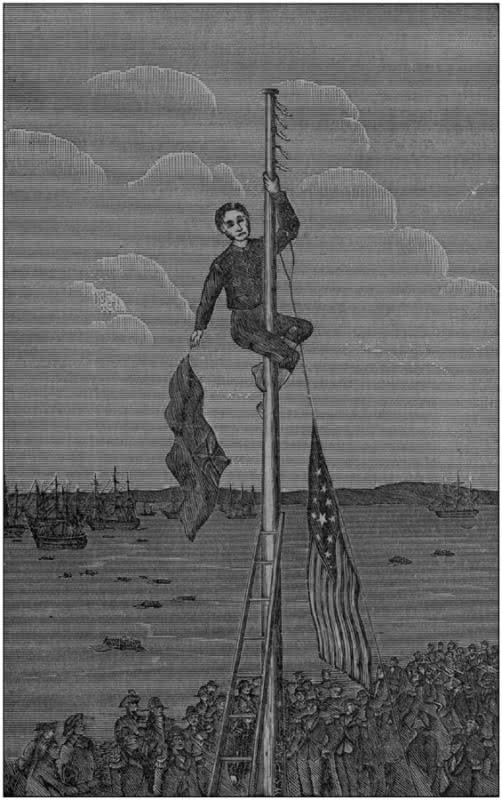
Thus, I will begin from Riker’s text and supplement it as needed with other informative resources, all of which will be listed in the footnotes.
Lead-Up to November 25, 1783 Evacuation Day
1783 would mark the end of the American War of Independence. The Treaty of Paris, formally ending the War, was signed on September 3, 1783,4 but news of impending peace had long preceded the signing of the Treaty. Riker wrote that news of peace “was officially published at New York on April 7, 1783,” and that the news “was hailed with delight by every friend of his country.”5 However, what is now Manhattan not only remained under British occupation after April 8, but also after September 3. The commander in charge was General Guy Carleton. Riker explained Sir Carleton’s situation:
Sir Guy Carleton, the English commander at New York, was in honor bound not to give up the City till he had provided the means of conveying to places within the British possessions, all those who should decide to quit the country.6
Riker explains in more detail than we will go into in this article that there were many loyalists in New York City who were some combination of unable and unwilling to remain in post-independence America. Carleton was entrusted with arranging for an orderly evacuation of not just the British soldiers, but also the loyalist subjects of the crown. A tense situation persisted for several months before Carleton received his final orders to evacuate New York City in August 1783.7 Riker was an American patriot and he reflected the grievances of fellow patriots 100 years prior against civic decay and disorder during the four months it took Carleton to complete the evacuation of New York. However, he noted that Carleton did fulfill a promise to allow slaves (New York was a slave state in 1783) to join the evacuation and he credited Carleton with having ultimately completed a thankless task:
In this, as in the whole ordering of the evacuation, which was more than the work of a day, General Carleton must have credit for humanity and a disposition to pursue a fair and honorable course, which, under the extraordinary difficulties of the situation, required rare tact and discretion.8
A blog post by Mr. Michael D. Hattern went into even greater detail about Carleton’s logistical challenges in completing the evacuation and Washington’s exercise in patience waiting for the task to be done:
For Washington and the other civil authorities, much of the fall of 1783 was spent waiting for Gen. Carleton to finish evacuating the city and fretting over the transfer of power. In eighteenth-century terms, the logistics of evacuation were staggering. There were twenty-thousand British soldiers in the city along with an institutional infrastructure seven years in the making that needed to be dissembled. In addition to the army, there were an estimated thirty five-thousand loyalists within the city, almost all of whom would seek to take up the Crown’s offer of relocation either to England itself (mostly for the elites) or to other imperial outposts, particularly Nova Scotia or the Caribbean.9
Eager patriots met at Cape’s Tavern on Broadway on November 18, 1783, to discuss preparations for receiving General Washington and maintaining order after the formal transfer of New York from British to American authority:
A large number of the inhabitants of New York, lately returned from a seven years’ exile, met at Cape’s Tavern, Broadway, on Tuesday evening, November 18th. At this meeting it was requested that every person present, who had remained in the city during the late contest, should leave the room forthwith; and it was resolved that no one who had remained or returned within the British lines during the war, be admitted to any future meetings. They pledged themselves to prevent, to the utmost of their power, all disorder and confusion that might follow the evacuation of the city by the British troops, and a committee of thirteen was appointed to meet at Simmons’ Tavern in Wall Street to settle on a badge of distinction to be worn on evacuation day, select the place of meeting, and agree as to the manner in which they should receive his Excellency, the Governor, on that day.10
Carleton initially reached an agreement with Washington that the evacuation would be completed on November 22, 1783, and General Washington, along with General Henry Knox and New York Governor George Clinton, marched to Harlem on November 20 to commence festivities, but Carleton ultimately needed another three days, causing a small delay.11
November 25, 1783
“Finally, the day fixed upon for the evacuation, and for the triumphal entry of Washington and the American army, to take possession of the city, was Tuesday, the 25th of November.”12 Washington’s entry was timed such that there would be almost no delay between the British authorities leaving a section of Manhattan and Washington entering it with his soldiers and New York government officials: “[T]he Americans were to promptly advance and occupy the position as the British vacated them; the latter, when ready to move, to send out an officer to notify our advance guard.”13
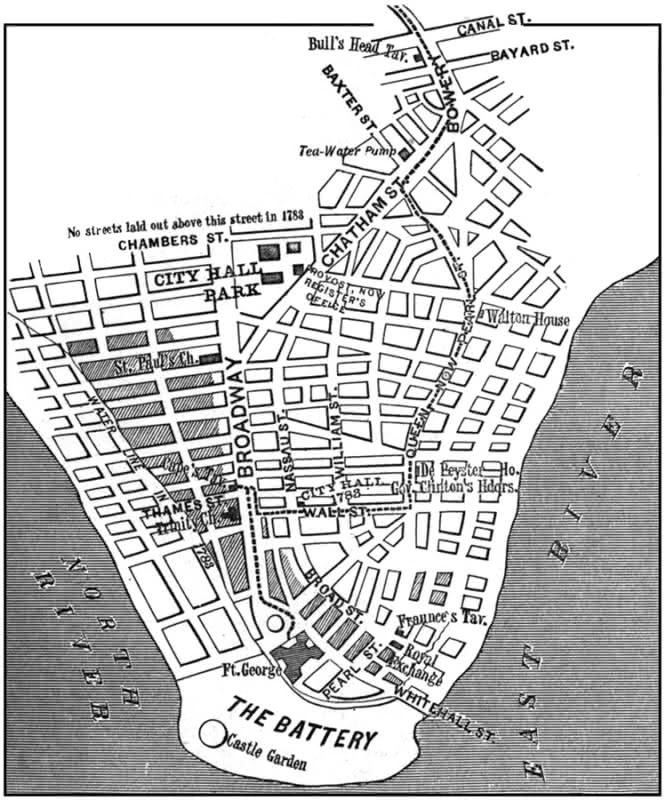
General Henry Knox began marching with American troops from McGowan’s Pass in Harlem in the early morning. Riker retold that Knox stopped his march at Bowery Street and Third Avenue at about 1:00 PM while the British soldiers waited for their orders to pull out.14 Once the order was given, General Knox began slowly taking possession of Manhattan streets as his troops filled the void left by the departing British soldiers.15 Upon reaching Bull’s Head Tavern, Knox received General Washington and New York Governor George Clinton:
Our troops having halted and taken their position opposite and below Cape’s Tavern,[2] Gen. Knox quitted them, and heading a body of mounted citizens, lately returned from exile, and who had met by arrangement at the Bowling Green, each wearing in his hat a sprig of laurel, and on the left breast a Union cockade, made of black and white ribbon, rode up into the Bowery to receive their Excellencies General Washington and Governor George Clinton, who were at the Bull’s Head Tavern (site of the Thalia Theatre), they having arrived at Day’s Tavern, Harlem, on the 21st inst., the very day on which Carleton had drawn in his forces and abandoned the posts from Kingsbridge to McGown’s Pass, inclusive.16
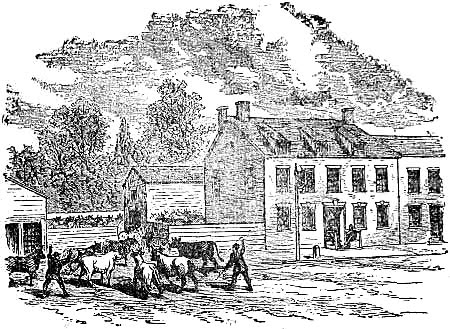
Washington then led the march to Fort George:
General Washington, “straight as a dart and noble as he could be,” riding a spirited gray horse, and Governor Clinton, on a splendid bay, with their respective suites also mounted; and having as escort a body of Westchester Light Horse, under the command of Capt. Delavan.18
(Note: Fort George no longer exists. The Alexander Hamilton Customs House, which today houses The Museum of the American Indian, sits on the spot once occupied by Fort George.)19
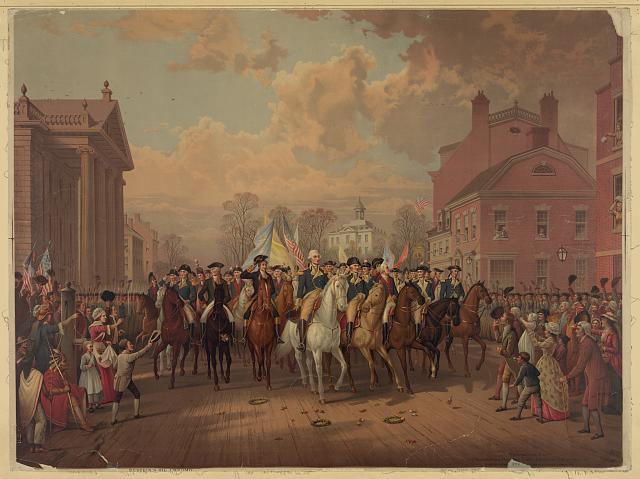
Riker detailed Washington’s route through lower Manhattan (also see map I posted a few paragraphs supra):
Near the Tea-water Pump, (in Chatham street just above Pearl), where the citizens on foot had gathered to join the procession, Washington halted the column, while Gen. Knox and the officers of the Revolution drew out and, forming into line, marched down Chatham street, passing a body of the British troops which were still halting in the fields (now the City Hall Park); while Washington and the rest, turning down Pearl street, proceeded on to Wall street, and up Wall, then the seat of fashionable residences, to Broadway, where both companies again met, and while our troops in line fired a feu-de-joie, alighted at the popular tavern before mentioned, kept by John Cape, where now stands the Boreel Building.21
This indirect route was chosen “in order to avoid having the General march by all the ruins on Broadway, the leftovers of the fire of 1776 and seven years of occupation.”22 While Riker did not include the detail about why Washington’s route avoided much of Broadway, he had explained:
The seven years’ occupation by the enemy had reduced the town to a most abject condition; many of the church edifices having been desecrated and applied to profane uses; the dwellings, which their owners had vacated on the approach of the enemy, being occupied by the refugee loyalists, and officers and attachés of the British army, were despoiled and dilapidated; while a large area of the City, ravaged by fires, still lay in ruins!23
(Note: Riker specified in a more detailed footnote that there were two major fires, the first in 1776 and the second in 1778, with the former fire rendering the latter one “a small affair in comparison.”24)
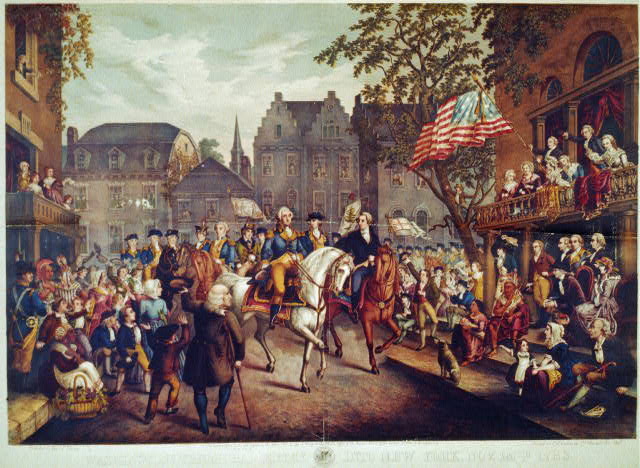
The procession finally reached its objective: Fort George. However, General Washington and his men found an unexpected item left behind by the evacuees:
But now a sight was presented, which, as soon as fully understood, drew forth from the astonished and incensed beholders execrations loud and deep. The royal ensign was still floating as usual over Fort George; the enemy having departed without striking their colors, though they had dismantled the fort and removed on shipboard all their stores and heavy ordnance, while other cannon lay dismounted under the walls as if thrown off in a spirit of wantonness.26
This delayed General Washington’s entry into the fort, for the General had previously indicated that he would only enter the Fort when the American Flag was flying.27 Why had the advance troops not yet replaced the British flag? Sabotage:
On a closer view it was found that the flag had been nailed to the staff, the halyards taken away, and the pole itself besmeared with grease; obviously to prevent or hinder the removal of the emblem of royalty, and the raising of the Stars and Stripes. Whether to escape the mortification of seeing our flag supplant the British standard, or to annoy and exasperate our people were the stronger impulse, it were hard to say. It was too serious for a joke, however, and the dilemma caused no little confusion.28
The confusion was so perplexing that some in the anxious crowd called for the flag pole to be chopped down.29 But surely the heroes of the Revolution could devise a more elegant solution to the Crown’s final act of whimsy. James Riker described the man who would become the hero of the day (and the man who also happened to be Riker’s grandfather):
The scene grew exciting: and now appeared another actor, hitherto looking on, but no idle observer of what was passing. He was a young man of medium height, whose ruddy honest face, tarpaulin cap and pea-jacket told his vocation. Born neither to fortune nor to fame, yet by his own merits and exertions he had won the regard of some in that assembly, having served under McClaughry, and Willett, and Weissenfels, as also the Clintons, to whom he had lived neighbor, within that patriotic circle in old Orange, where these were the guiding spirits, and every yeoman with them, shoulder to shoulder, in the common cause. As a subaltern officer he had made a good record during the war, and none present, however superior in station, had sustained a better character or exhibited a purer patriotism. This was John Van Arsdale, late a Sergeant in Capt. Hardenburgh’s company of New York Levies. At nineteen years of age, quitting his father’s vessel, where he had been bred a sailor, he enlisted in the Continental Army at the beginning of the war, and had served faithfully till its close. Suffering cold and hardship in the Canada expedition, wounded and taken prisoner at the battle of Fort Montgomery, he had languished weary months in New York dungeons, and in the foul hold of a British prisonship, and subsequently braved the perils of Indian warfare in several campaigns. And with such a record, where expect to find him but among his old compatriots, on this day of momentous import, when the struggles of seven years were to culminate in a final triumph.30
Captain Van Arsdale volunteered to climb the greasy staff after others had failed. His initial attempt to climb the staff was unsurprisingly unsuccessful. But Van Arsdale’s spirit inspired American ingenuity:
Now it was proposed to replace the cleats which had been knocked off; and persons ran in haste to Peter Goelet’s hardware store, in Hanover Square, and returned with a saw, hatchet, gimlets, and nails. Then willing hands sawed pieces of board, split and bored cleats, and began to nail them on.31
Replacing the cleats on the flag pole set the stage for Van Arsdale’s triumph:
By this means Van Arsdale got up a short distance, with a line to which our flag was attached; but just then, a ladder being brought to his assistance, he mounted still higher, then completed the ascent in the usual way, and reaching the top of the staff, tore down the British standard, and rove the new halyards by which the Star-spangled Banner was quickly run up by Lieut. Anthony Glean, and floated proudly, while the multitude gave vent to their joy in hearty cheers, and the artillery boomed forth a national salute of thirteen guns!32
With the American flag flying high over Fort George, New York was now aesthetically, as well as practically, under American control.
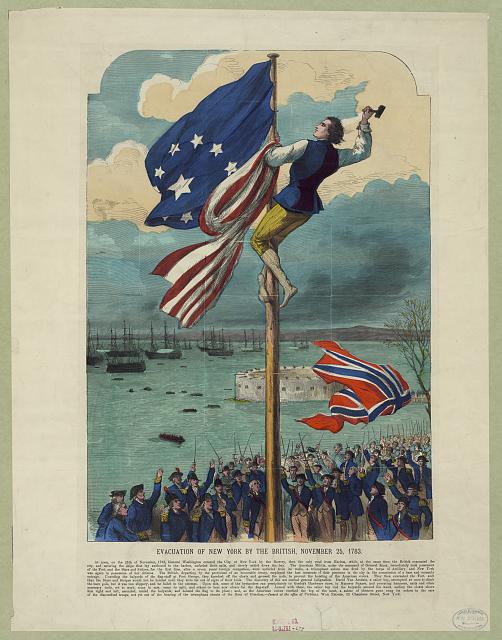
In gratitude, the crowd foisted unsolicited honors on the nimble captain:
On descending, Van Arsdale was warmly greeted by the overjoyed spectators, for the service he had rendered; but some one proposing a more substantial acknowledgement than mere applause, hats were passed around, and a considerable sum collected, nearly all within reach contributing, even to the Commander-in-Chief. Though taken quite aback, Van Arsdale modestly accepted the gift, with a protest at being rewarded for so trivial an act. But the contributors were of another opinion; he had accomplished what was thought impracticable, and the occasion and the emergency made his success peculiarly gratifying to all present.34
Note that General Washington chipped into the pot for Van Arsdale. Riker added a fun detail to the story that he was privy to as Van Arsdale’s grandson:
On returning home to his amiable Polly (they had been married short of six months), the story of “Evacuation Day,” and the silver money which he poured into her lap, caused her to open her eyes, and fixed the circumstance indelibly in her memory!35
Washington capped his triumphant return to New York by going to Fraunces Tavern on Pearl and Broad Streets.36 (Fraunces Tavern still stands today.37) “After the formalities attending the reception Governor Clinton gave a public dinner at Fraunces’ Tavern, at which the Commander-in-Chief and other general officers were present.”38 The 120 individuals present39 at Fraunces Tavern delivered 13 toasts to:40
- The United States of America.
- His most Christian Majesty.
- The United Netherlands.
- The King of Sweden.
- The American Army.
- The Fleet and Armies of France, which have served in America.
- The Memory of those Heroes who have fallen for our Freedom.
- May our Country be grateful to her Military Children.
- May Justice support what Courage has gained.
- The Vindicators of the Rights of Mankind in every Quarter of the Globe.
- May America be an Asylum to the Persecuted of the Earth.
- May a close Union of the States guard the Temple they have erected to Liberty.
- May the Remembrance of THIS DAY, be a Lesson to Princes.
I concur with Mr. James Kaplan of The New York Almanack wherein he opined that “[t]he thirteen toasts themselves are interesting because they provide a window into the thinking of the men who had just won the arduous fight against the British at their moment of greatest triumph.”41 Mr. Kaplan singled out 11 and 13 as his favorite. I am personally partial to 9, but for reasons we shall explore shortly, toasts 7 and 8 are particularly relevant to the rise and fall of Evacuation Day as a New York holiday.
December 1783
On December 2, celebrations were held to mark the signing of a formal peace treaty with the British:
On the following Tuesday, December 2d, at the same place, another such entertainment was given by Governor Clinton to the French Ambassador, Luzerne, to which invitations were also extended to Washington and his officers. For this Cape rendered a bill to the State, in which he made charge for 120 dinners, 135 bottles of Madeira, 36 bottles of Port, 60 bottles of English Beer and 30 Bowls of Punch. In putting away this liberal supply of drink, they must have had a jolly time, and that some of them became very unsteady is indicated by a significant charge made by Cape for 60 broken wine glasses and 8 cut glass decanters. In the evening there was a grand display of fire works in celebration of the Definite Treaty of Peace between Great Britain and the United States of North America, at the Bowling Green, in Broadway. These, it is said, infinitely exceeded every[Pg 316] former exhibition of the kind in the United States.42
Finally, on December 4, General Washington bid New York farewell:
On Thursday, the 4th, Gen. Washington bade a final adieu to his fellow officers at Fraunces’ Tavern. The scene was most affecting. ‘With a heart full of love and gratitude,’ said he, ‘I now take leave of you, and most devoutly wish that your latter days may be as prosperous and happy as your former ones have been glorious and honorable.’ Embracing each one in turn, while tears coursed down their manly checks, he parted from them, and from the City, to resign his commission to Congress, and seek again the retirement of private life.43
Thus General Washington, who rendered his country a remarkable service in leading its armies to a successful conclusion in the American War of Independence, rode off to a well-deserved retirement. This is a retirement that was sure to stick. He would certainly have no cause to return to Manhattan several years later to deliver some speech about something or other.
But I digress. This concludes the story of the British evacuation of New York on November 25, 1783. We now move to examine how the day was commemorated in future years.
The History of Evacuation Day as a New York Holiday
Evacuation Day immediately became a popular holiday in New York. Celebrations were held on November 25, 1784, and a flag was raised at the site of Captain Van Arsdale’s climb in 1783 with somewhat less drama.44 Ms. Megan Margino explained that Evacuation Day became the second most significant patriotic holiday in New York after Independence Day, and often featured “fireworks, public banquets, military drills, parades, and patriotic plays.”45 Early Evacuation Day ceremonies often featured veterans of the Revolutionary War, including Mr. Van Arsdale and members of his family:
In the years immediately following 1783 there were spontaneous demonstrations and parades on Evacuation Day, largely led initially by Revolutionary War veterans. It was on Evacuation Day in 1790 that the New York Artillery Volunteers were formed as a company of soldiers designed to defend the City. The members of this group, which to this day exists and fires a 50 gun salute on the fourth of July in Lower Manhattan, included John Van Arsdale, who had pulled down the British flag at Bowling Green . . . It was invariably marked by a ceremony at Bowling Green in which a descendant of John Van Arsdale had the honor of raising the American flag (and in some accounts reenacting the original climb).46
I found a detailed account of the 1793 festivities marking the 10th anniversary of the evacuation:
On Monday, November 25, 1793, the tenth anniversary of the evacuation of New York by the British troops, was celebrated in the city with great enthusiasm. At sunrise a salute was fired from the Battery followed immediately by the ringing of all the bells in the city. This was repeated at noon, when the corporation, the officers of the militia, the French officers in town and many citizens waited on the Governor to congratulate him on the occasion. The militia officers then waited on the mayor of the city, the chief justice of the United States and the minister of the French Republic. The Ambuscade Frigate was elegantly decorated and at one o’clock fired a salute of twenty-one guns. The militia officers, honored with the company of the Governor, General Gates and a number of French officers, sat down to an elegant dinner prepared for them at the City Tavern, “where they spent the remainder of the day in great spirits and good fellowship.” Toasts were drunk under the discharge of artillery. The gentlemen of the corporation celebrated the day at the Tontine Coffee House, where an elegant dinner was served up by Mr. Hyde and patriotic toasts were drunk. The Society of Tammany also celebrated the day. At the tavern of Robert Hunter, in Wall Street, a dinner was served up to a number of citizens in celebration of the day, and the same was done in several other of the principal taverns of the city.47
Ms. Margino found that New York City endeavored to cap the budget for holiday festivities in 1809, but that the effort was unsuccessful.48 1813 brought with it Evacuation Day banquets at New York City’s major taverns, including the iconic Fraunces Tavern:
In 1813, on the celebration of the thirtieth anniversary of the Evacuation, the Independent Veteran Corps of Artillery, after performing the duties of the day, partook of a dinner at this old historic tavern, which seems to have been their headquarters. It was then kept by Rudolphus Kent. This was repeated the next year on Evacuation Day.49
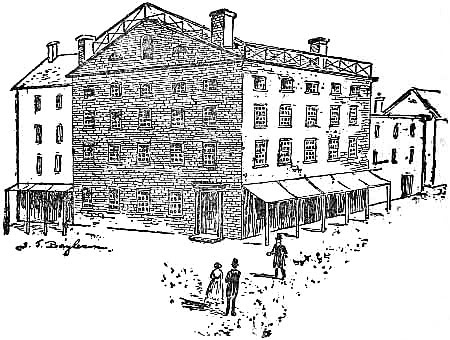
However, Evacuation Day would see its prominence wane. Ms. Margino suggested that interest in the holiday waned in the mid nineteenth century as veterans of the Revolutionary War began to pass away and no one took up the mantle of celebrating Evacuation Day with the same enthusiasm of those who fought in the war.51 Mr. Kaplan stated that The New York Times attributed the decline in interest in Evacuation Day in an 1850 article to the death of all of the War veterans.52 Writing in 1883 on the eve of what would be the grandest and final grand Evacuation Day celebration, Riker, who was personally acquainted with veterans of the War of Independence in his youth, notably his esteemed grandfather, John Van Arsdale, tied the occasion of the centennial remembrance of the Evacuation to the memory of those who won America her independence:
With the expiring century has also disappeared the host of brave actors in that eventful drama! Memory, if responsive, may bring up the venerable forms of the ‘Old Seventy Sixers,’ as they still lingered among us two score years ago; and perchance recall with what soul-stirring pathos they oft rehearsed “the times that tried men’s souls.” But they have fallen, fallen before the last great enemy, till not one is left to repeat the story of their campaigns, their sufferings, or their triumphs. But shall their memories perish, or their glorious deeds pass into oblivion? Heaven forbid! Rather let us treasure them in our heart of hearts, and speak their praises to our children; thus may we keep unimpaired our love of country, and kindle the patriotism of those who come after us. To-day they shall live again, in the event we celebrate.53
Other factors played a role in the decline of Evacuation Day. Firstly, the November 25 holiday was only celebrated in New York.54 Ms. Margino found that the holiday invoked bemusement in some newspapers outside of New York City and some in New York City questioned why it was a holiday.55 Finally, the increasing recognition of Thanksgiving, which was and is national in scope, toward the latter half of the nineteenth century further diminished Evacuation Day.56
In 1883, New York City marked Evacuation Day with renewed vigor in honor of the centennial of the event that inspired the holiday. As I noted, James Riker’s detailed and insightful history of Evacuation Day and biography of John Van Arsdale was written for the occasion.
Ms. Margino described the event as follows:
The last spark in Evacuation Day celebrations followed the Civil War, and the holiday’s 1883 centennial proved to be monumental. Led by the city’s military and business leaders, event highlights include a parade of 20,000 marchers (taking over four hours to pass any single location).57
New York Governor and future President Grover Cleveland unveiled a statue of George Washington at the Federal Hall building.58 (The statue is still present.59) Ms. Margino noted that there were approximately 500,000 spectators at all of the 1883 Evacuation Day events in New York City.60
Riker added a section to his 1883 book, noting with sadness that his Uncle David Van Arsdale, who was son of John Van Arsdale, passed away at age 87 on November 14, 1883, just 11 days before the centennial celebrations. While Riker felt great regret that David Van Arsdale would not be able to play the special role in the celebrations that had been planned for him, he noted with gratitude that “the City Press is teeming with obituaries expressive of respect for his memory.”61
(1883 was a year of big celebrations in New York City. Almost exactly six months prior to the Evacuation Day celebration, hundreds of thousands of New Yorkers celebrated the opening of the magisterial Brooklyn Bridge connecting Brooklyn and Manhattan over the East River, which I covered in a separate article.)
Evacuation Day saved what may have been its best for last. While the holiday continued on in later years, interest continued on its negative pre-1883 trajectory. Ms. Margino suggested that Evacuation Day was “no longer feasible or desired by the city’s rapidly expanding and diverse population.”62 Whether that is the correct explanation, it made me take note of the fact that the official program for the 1883 celebration made special mention of George Washington’s support for the people of Ireland and their struggle for their rights in remarks delivered on November 20, 1783.63 Mr. Kaplan attributed the decline in interest in Evacuation Day to the primacy of Thanksgiving and other events happening in late November.64 Whatever the causes, the final official observance New York City came on November 25, 1916, after which then New York City Mayor John Puroy Mitchel called for an end to the celebrations on account of the United States’ alliance with Great Britain in the First World War, which it entered in 1917.65
Evacuation Day Today
While Evacuation Day is no longer an official holiday in New York City, much less a credible rival to Independence Day, there are groups working it keep its memory and traditions alive. The Sons of the Revolution hold an annual event at Fraunces Tavern.66 Then New York City Council President Paul O’Dwyer began holding an annual reception at New York City’s City Hall in the 1980s.67
In recent years, the Lower Manhattan Historical Society has taken the lead in celebrating Evacuation Day.68 The Society will carry out a small public Evacuation Day celebration on November 25, 202369 featuring the following events:
- 12:30 p.m. Assemble at front of Fraunces Tavern – 54 Pearl Street
- 12:40 p.m. Procession begins from Fraunces Tavern – 54 Pearl Street
- 1:00 p.m. Flag Raising at Evacuation Day Plaza (Bowling Green)
If you happen to be in New York City, you can follow the Lower Manhattan Historic Society for future Evacuation Day plans.
Conclusion
Evacuation Day is a very old-time patriotic holiday in New York City that few New Yorkers today are much aware of. While the Evacuation Days of 1793, 1813, and 1883 are not coming back, I appreciate the efforts of the Lower Manhattan Historic Society and others to keep the holiday alive. Firstly, in a day and age when there appears to be much undue hostility toward the Founding Generation that secured America’s independence and laid the foundation for her liberty, a dose of unabashed patriotism is a fine thing. The United Kingdom today seems to have similar issues to America regarding hostility to the past, so we can revive Evacuation Day without too much undue offense while sharing Veteran’s Day (which is closely tied to Remembrance Day in the United Kingdom) and other occasions that tie into the deep and enduring friendship between our nations.
Another point in favor of Evacuation Day’s revival is a point that may have contributed to its downfall: It is a distinctly New York holiday. That it was only celebrated in New York makes sense in light of the fact that November 25, 1783, was specifically significant to the patriots of New York who had suffered throughout the War of Independence. Moreover, it served as a fitting bookend for General Washington’s service, the ups and downs of which were found in New York. While I understand that my fellow New Yorkers are very particular about things such as pizza and how to eat pizza, I think it would be healthy for New York City to take more pride in its important place in American history. Evacuation Day serves as a reminder of the important role New York City played in the Revolution and those who fought, suffered, and gave their lives to secure its liberty for posterity.
I hope you enjoyed my long history of a now-obscure holiday, and I hope that my essay inspires more New Yorkers (and people outside of New York for remembering the patriots who fought in the War of Independence) to take a moment to think of Evacuation Day on November 25, 1883.
Footnotes
- Saraniero, Nicole. “Evacuation Day, New York City’s Forgotten November Holiday.” Untapped New York (blog), November 14, 2023. https://untappedcities.com/2023/11/14/evacuation-day-new-york-citys-forgotten-november-holiday-2/. ↩︎
- Riker, James. “‘Evacuation Day’, 1783, Its Many Stirring Events With Recollections of Capt. John Van Arsdale, of the Veteran Corps of Artillery, by Whose Efforts on That Day the Enemy Were Circumvented, and the American Flag Successfully Raised on the Battery.” https://www.gutenberg.org/files/33419/33419-h/33419-h.htm. Accessed November 24, 2023. https://www.gutenberg.org/ebooks/33419/pg33419-images.html. ↩︎
- Id. at 56 n.33. ↩︎
- National Archives. “Treaty of Paris (1783),” April 16, 2021. https://www.archives.gov/milestone-documents/treaty-of-paris. ↩︎
- Riker at 4. ↩︎
- Id. ↩︎
- Id. at 6. ↩︎
- Id. ↩︎
- Hattern, Michael D. “The Story of ‘Evacuation Day.’” The Junto (blog), November 25, 2014. https://earlyamericanists.com/2014/11/25/the-story-of-evacuation-day/. ↩︎
- Bayles, William Harrison. “Old Taverns of New York.” https://www.gutenberg.org/files/44240/44240-h/44240-h.htm. Accessed November 24, 2023. https://www.gutenberg.org/ebooks/44240/pg44240-images.html. Pp. 312. ↩︎
- Hattern. ↩︎
- Riker at 8. ↩︎
- Id. at 9 ↩︎
- Id. ↩︎
- Id. ↩︎
- Id. at 10. ↩︎
- Bayles at 157. ↩︎
- Riker at 10. ↩︎
- Brady, Meghan. “Fort George.” History of New York City (blog), December 13, 2016. https://blogs.shu.edu/nyc-history/2016/12/13/fort-george/. ↩︎
- Restein, Edmund P., Lithographer, and Ludwig Restein. “Evacuation day” and Washington’s triumphal entry in New York City, Nov. 25th. United States, 1879. [Phil., PA: Pub. E.P. & L. Restein] Photograph. https://www.loc.gov/item/2003652651/. ↩︎
- Riker at 18. ↩︎
- Hattern. ↩︎
- Riker at 4. ↩︎
- Id. 9 & n.1 ↩︎
- Inger, Christian, Lithographer, and P.S. Duval & Son. Washington’s triumphal entry into New York, Nov. 25th,/ C. Inger lith. United States, ca. 1860. [Philadelphia: Published by Geo. T. Perry, Phila.: Printed in oil colors by P.S. Duval & Son] Photograph. https://www.loc.gov/item/2003652650/. ↩︎
- Id. at 15. ↩︎
- Kaplan, James S. “A Short History of New York City’s ‘Evacuation Day.’” New York Almanack (blog), November 25, 2021. https://www.newyorkalmanack.com/2021/11/a-short-history-of-evacutaion-day-in-nyc/. ↩︎
- Riker at 15. ↩︎
- Hattern. ↩︎
- Riker at 16. ↩︎
- Id. ↩︎
- Id. at 16-18 ↩︎
- Evacuation of New York by the British. United States New York, ca. 1883. New York: Issued at the office of Pictorial War Record, 12 Chambers Street, November 30. Photograph. https://www.loc.gov/item/2006678643/. ↩︎
- Riker at 18. ↩︎
- Id. ↩︎
- Id.. ↩︎
- Atlas Obscura. “Fraunces Tavern.” Accessed November 24, 2023. http://www.atlasobscura.com/places/fraunces-tavern. ↩︎
- Bayles at 314-15. ↩︎
- Margino, Megan. “Evacuation Day: New York’s Former November Holiday.” The New York Public Library (blog), November 24, 2014. https://www.nypl.org/blog/2014/11/24/evacuation-day-new-york-holiday. ↩︎
- Riker at 18-19. ↩︎
- Kaplan. ↩︎
- Bayles at 315-16. ↩︎
- Riker at 20. ↩︎
- Margino. ↩︎
- Id. ↩︎
- Kaplan. ↩︎
- Bayles at 370-71. ↩︎
- Margino. ↩︎
- Bayles at 412. See also Pp. 430: “A dinner was served [at Shakespeare Tavern] to Captain Swain’s Company of the Third Regiment of Artillery on Evacuation Day, 1813.” ↩︎
- ↩︎
- Margino. ↩︎
- Kaplan. ↩︎
- Riker at 3. ↩︎
- Saraniero. ↩︎
- Margino. ↩︎
- Id. ↩︎
- Margino. ↩︎
- Brette, John. Centennial Celebration of the Evacuation of New York City : Monday, November 26th, 1883 : With an Historical Outline and Order of Procession. New York : John Polhemus, 1883. http://archive.org/details/centennialcelebr00bret. ↩︎
- “Federal Hall National Memorial (U.S. National Park Service).” Accessed November 24, 2023. https://www.nps.gov/places/000/federal-hall-national-memorial.htm. ↩︎
- Margino. ↩︎
- Riker. ↩︎
- Margino. ↩︎
- Brette at 7. ↩︎
- Kaplan. ↩︎
- Margino; Kaplan. ↩︎
- Kaplan. ↩︎
- Id. ↩︎
- “NYC: Evacuation Day Events Planned for Friday – New York Almanack,” November 22, 2016. https://www.newyorkalmanack.com/2016/11/nyc-evacuation-day-events-planned-for-friday/. ↩︎
- LOWER MANHATTAN HISTORICAL ASSOCIATION. “Evacuation Day Commemoration,” November 25, 2023. https://www.historiclowermanhattan.org/upcoming-events/evacuation-day. ↩︎